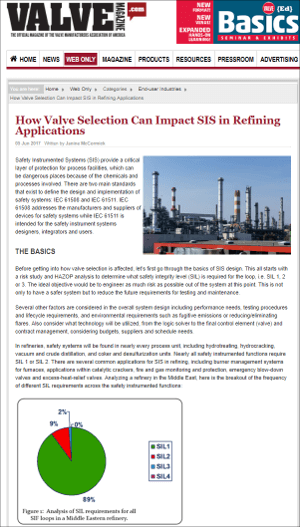 Valves are critical components inside of safety instrumented functions (SIFs) since they do the work of touching the process flows to bring the plant to a safe state in the event of a safety demand.
Valves are critical components inside of safety instrumented functions (SIFs) since they do the work of touching the process flows to bring the plant to a safe state in the event of a safety demand.
In a Valve magazine article, How Valve Selection Can Impact SIS in Refining Applications, Emerson’s Janine McCormick describes the important criteria in finding the right valve for the required safety performance.
 Janine opens describing the basics of safety instrumented system (SIS) design, which:
Janine opens describing the basics of safety instrumented system (SIS) design, which:
…all starts with a risk study and HAZOP [hazard and operability study] analysis to determine what safety integrity level (SIL) is required for the loop, i.e. SIL 1, 2 or 3. The ideal objective would be to engineer as much risk as possible out of the system at this point. This is not only to have a safer system but to reduce the future requirements for testing and maintenance.
SIL defines the relative risk-reduction performance required for a SIF. A refinery has many units which require SIFs. Some of these include:
…hydrotreating, hydrocracking, vacuum and crude distillation, and coker and desulfurization units. Nearly all safety instrumented functions require SIL 1 or SIL 2. There are several common applications for SIS in refining, including burner management systems for furnaces, applications within catalytic crackers, fire and gas monitoring and protection, emergency blow-down valves and excess-heat-relief valves.
Valve selection is not just about suitability for the SIL level, but also the service in which it will operate.
It’s important, as with any valve selection, to consider the valve type, materials and fluid challenges in addition to the product safety certification. The failure rates given from the certifying body often assume clean service. The safety instrumented system designer will use his or her discretion to select the most appropriate valve configuration.
Another important consideration for highly-engineered valve solutions is to find a supplier who can integrate the valve assembly components, which may come from different suppliers, to ensure they work together to meet the risk-reduction requirements.
Given the wear on valves over time, testing is done to help assure they meet the risk reduction requirements.
The most conventional way to test a valve is to take the valve offline and perform a full stroke valve test, known as a proof test.
Partial stroke testing:
…can be used to extend the time between full proof tests. Some refiners have adopted partial stroke testing for many of their safety valves, some leverage it for valves that do not have bypasses, and others currently don’t use this at all. A partial stroke test can identify many failure modes, but it cannot identify everything that a full stroke proof test would capture.
Read the article for a table of some of the failure modes that partial stroke tests can and cannot determine, as well as examples of how digital valve controllers can spot failure modes that manual visual testing cannot, as well as record history of safety demands to be counted as full proof tests.
You can connect and interact with other functional safety and valve experts in the Safety Instrumented Systems and Valves groups in the Emerson Exchange 365 community.
Update: I received this feedback from a reader about the assumption of clean service in the quote above, “Even certifying authority like EXIDA distinguish failure rates of valve separately for clean, severe service. Even though it is not taken care of in failure rates those will be part of systematic failure rates and have to be taken care in design stage by having stringent specifications.”
I connected back with Janine and Afton Coleman and wanted to share their response, “The reader is correct in that not every certifying body assumes clean service. The intention of the article excerpt being discussed is to encourage users to consider proper selection based on valve application and sizing rather than selecting a valve solely based on SIL capability—this should be properly addressed in the specifications but also considered during SIL verification. Service case assumptions published on certificates are in part based vendor feedback regarding a typical service, and some certificates may cover both clean and severe service.
For example, Fisher valve SIL certificates from exida often cover both clean and severe service, and we encourage users to take the service case options (which are typically found on the cert or FMEDA report) into consideration against the process service conditions specified to apply the proper failure rates during SIL verification.”
